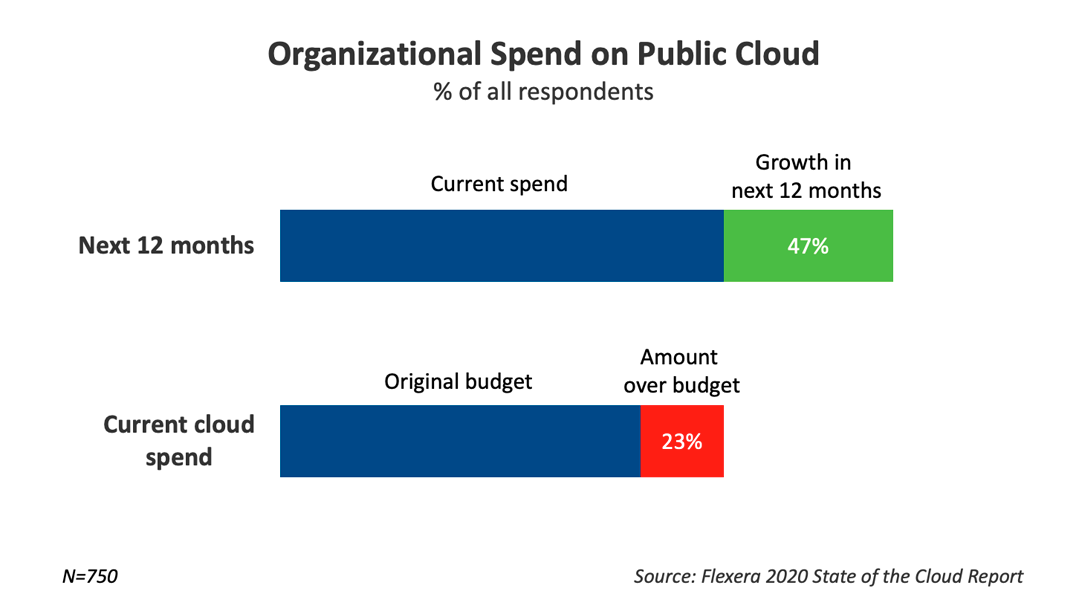Cloud adoption has become mainstream across businesses. As enterprises are developing, they are leveraging cloud technologies to place a significant amount of workload in cloud platforms to bring more value to their employees and customers.
When enterprises adopt cloud strategies, there are often challenges such as managing cloud costs, and overspending. Tracking cloud activities is important or else cloud computing costs can get out of hand. With an increase in cloud usage, there is also an increase in cloud waste.
Many factors lead to cloud overspending. Let’s discuss the main reasons for cloud overspending and how businesses can optimize cloud use and cost.
Cloud waste is estimated to reach $21 billion by 2021"
Why Enterprises Overspend on Cloud Services
Adopting a cloud service is vital to improve efficiency and increase scale. Adopting these services is beneficial as long as it stays within budget. Here are some common reasons for overspending that are often ignored.
-
Failing to understand cloud computing requirements. When businesses fail to identify their actual needs, they spend more on cloud computing services.
-
No proper analysis to clearly estimate how much data is generated or stored. In such situations, businesses will end up overspending on data storage services.
-
Failure to understand plans and pricing offered by a cloud service provider. Depending on the industry and the customer requirements, cloud service prices and plans may vary. When companies fail to understand the different plan options, they fail to select the right plan.
- Un-optimized systems before performing cloud migration process. This results in inaccurate evaluation, and companies fail to get rid of unnecessary, redundant data. This affects their entire analysis, which makes it challenging to choose the right cloud service plan.
How to Avoid Overspending on Cloud Services
There are many enterprises that are unaware of the factors that can lead to cloud overspending and without even realizing it, they waste a lot of money. In order to avoid overspending on cloud services, enterprises must focus on key points before choosing any cloud services. Here are some ways to optimize your cloud use and manage cloud expenses.
1. Understand the Cloud
One of the reasons why enterprises end up overspending is the lack of knowledge and understanding of cloud services. Depending on the industry type, the service needs can vary, so stakeholders should completely understand their business needs in order to choose cloud services.
2. Cost Optimization
Calculate the monthly cloud spend of your organization to ensure cost optimization. Tracking all the services and prices offered by a cloud service provider helps minimize overspending. Focus on cloud use patterns to understand which services are being used and which are not. Analyze requirements to choose services either from multiple cloud service providers or single providers such as AWS or Azure or Google.
3. Control Resource Overprovision
To avoid overspending, it is vital to use the right amount of storage. Often, storage is wasted because businesses purchase more than what's needed. According to RightScale State of Cloud Report by Flexera, 40% of cloud instances are larger than the required workloads. Cloud storage is economical and affordable, but creating oversized instances is a waste of money.
4. Track Cloud vendors
Keep track of the cloud service providers, their licensing, and their subscription services. It is a complicated task but helps reduce cloud overspend. Enterprises that deal with multiple cloud vendors for different services should re-negotiate the vendor contracts at regular intervals. This helps reduce subscription costs.
5. Regular Assessment
Enterprises should run thorough assessments to identify the assets that are no longer needed and eliminate them. Conducting evaluations at regular intervals will help identify volumes of unwanted data. It is also advisable to invest in cloud cost optimization tools that help enterprises throughout the assessment and review process. Without a proper review, many companies continue to pay for the resources and services that they don't use.
6. Successful Cloud Implementation
During a cloud implementation and migration process, there are a large set of customizations that are needed by the enterprise. However, too many customizations can become a barrier and sometimes don't integrate well with the other applications. Make sure the cloud architecture is exactly in line with your business needs and is scalable enough and easily integrates with open source applications.



















